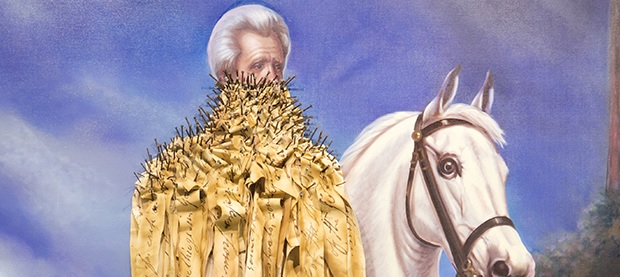Kaphar sampled aspects from this painting in his rendering and then attached pieces of torn canvas with rusted nails in order to expose the hidden context of Andrew Jackson’s social and political standing, which was elevated through the oppression of thousands of Native people. Each aspect of the work is a visual cue into history. The nails reference an African ritual of hammering nails into objects of adoration or spiritual significance. Each nail represents an individual that has put their faith into the object in question. The torn pieces of canvas are strips containing Andrew Jackson’s own words as he considers displacing Native Americans from their land. Jackson ended up signing the 1831 Indian Removal Act, which led to the forced relocation of Native people into Indian Territory (now Oklahoma) west of the Mississippi River. The route that these 15- to 16,000 Indigenous people forcibly traversed—called the Trail of Tears—is about 2,200 miles long and resulted in the death of an estimated three to four thousand people.
This acquisition looks to the collection’s earlier works of picturesque representations of our nation’s past and leaders, along with the sometimes violent realities of this history. Kaphar’s work simply makes visible that which art history has largely hidden: the fact that depictions of white supremacy are deeply embedded into our nation’s visual history. By engaging contemporary art as a means of starting a dialogue between the past and the present, we can begin to confront our history in order to move forward into a more just future.
To learn more about Titus Kaphar’s work and philosophy, follow the link here to watch his recent Ted Talk, “Can art amend history?”.

Titus Kaphar




